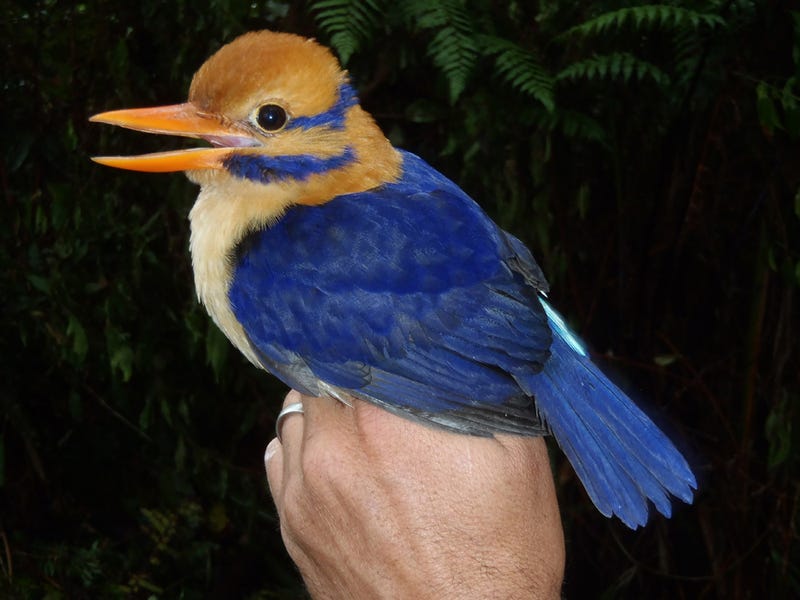For my blog today, I’m going to write about a bird, one that
can possibly be rare. Or it may not be,
no one knows, really.
Chris Filardi, who is the director of Pacific Programs at the
American Museum of Natural History in New York, was in the high forests of
Guadalcanal in the Solomon Islands, he heard the “ko-ko-ko-ko-kiew” call of a
bird that got him tremendously excited.
After days of tracking the bird, he and his colleagues captured a male
mustached kingfisher in a net.
Filardi had been searching for the beautiful orange, white,
and blue bird for more than 20 years before catching it. He told Slate
writer Rachel Gross that “it was like finding a unicorn.” It was very exciting.
This is the mustached kingfisher he captured.
They snapped some pictures of the male, the first of the
species documented. A female was
described back in the 1920s, but not a male; this was truly a momentous
occasion. After the team took pictures
to document the bird, they decided to do what almost anyone would do in their
situation…
They killed it.
Filardi’s team felt it was important for the scientific
community if they were to euthanize the mustached kingfisher as a “scientific specimen”
to study the species. There is a severe
lack of information on mustached kingfishers in general, also whether they are
endangered or simply elusive and rare. The
act has split the scientific community and the public on if killing wildlife in
the name of conservation is the right thing to do.
“Killing ‘in the name of conservation’ or ‘in the name of
education’ or ‘in the name of whatever’ needs to stop” University of Colorado
ecology professor Marc Bekoff wrote in an op-ed in the Huffington Post. “It is
wrong and sets a horrific precedent for future research and for children” he
goes on.
Filardi argues that the Guadalcanal variety is a different
species than the endangered Bougainville mustached kingfisher of Papua New
Guinea, and we simply do not know how many of the species there is, so they
need to be studied. And the only way
they can be studied, is by taking samples and dissecting them. In the story, Filardi says with the collected
samples, researchers now have a more comprehensive set of molecular, morphological,
and toxicological data and plumage data that can’t be garnered from blood
samples, individual feathers, or photographs.
Part of me understands why Filardi euthanized the bird, but
part of me finds it difficult to fathom.
Filardi had spent the last 20 years of his career searching for this
bird, so of course he would want to be able to provide a sample to study for
the knowledge of the species. Yet, the
bird was killed simply to study, and that is one less bird to enable the
species to continue. The species COULD or COULD NOT be endangered, so hopefully the gamble is worth the
knowledge.
To tie this into a Biblical aspect, I did not want to quote
the Ten Commandments, which seemed wrong.
So I honestly Googled “Bible verses about harming animals,” and found
two I would like to mention. The first
is Proverbs 12:10 “Whoever is righteous has regard for the life of his beast,
but the mercy of the wicked is cruel” (ESV).
The second is Psalm 145:9 “The Lord is good to all, and His mercy is
over all that He has made” (ESV again).
I am genuinely torn between if Filardi made the right decision, or if he
killed a beautiful animal in the name of science. Science often times requires deaths for
progress, and it has been animals that have paid with their lives. Lab rats have undergone testing for medicines
to help mankind, chimps have been sent to outer space so humans could go after
them. It’s an interesting conundrum that
I have. It doesn’t help when the bird
looks like he’s grinning at the camera.
Damn anthropomorphic animals!!
Tim:)
The original story can be found here

No comments:
Post a Comment